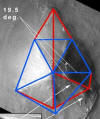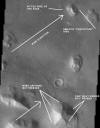|
After several months of waiting, we were treated Friday, April 12, 2002 to the first Mars Odyssey data to cover areas of interest to our now nearly two-decade long investigation into the Cydonia region of Mars. Unfortunately, we did not get what we had hoped for; a multi-spectral nighttime infrared image of the Face and surrounding structures.
Nor did we get a full-color image of the Cydonia complex in the promised 5-band color. What we did get was a nice grey-scale strip from the spacecraft's visible light camera. At 19 meters per-pixel, the image is substantially better resolution than the 50 meter per-pixel images we got in the Viking era. Still, it is an order of magnitude lower than the 1.5 meter per-pixel images we got in the best of circumstances from Mars Global Surveyor.
This does not prevent it from being useful. It is still a better overhead view of the center of the Cydonia complex than we have had before, allowing us to view the specific objects of interest in context and at a resolution we have not generally had (the D&M, for instance, has been almost completely missed in the publicly released images from Malin Space Science Systems). Previously identified objects of interest that are visible in the new Odyssey image strip include the Face, the D&M Pyramid, the Fort ... and some "surprises."
This " Massive
Tetrahedral Ruin " was first pointed out by Enterprise
principal
Part of the illusion was the extreme forced perspective of that original MGS image -- taken 45 ° off-nadir -- which effectively distorted the shape of the object. You can now see clearly from directly overhead that there are two distinct faceted walls that once made up this structure. The object lies just South of a suspiciously symmetrical "mesa" and -- conveniently -- lies at exactly 19.5° off the base symmetry axis of the D&M. This same axis passes right between the eyes of the Face. (more info about Number 19)
This five sided symmetry not only holds up extremely well in the new image (note especially the four clearly defined faceted sides to the Pentagonal pyramid meeting at a central apex -- exactly as observed by Hoagland and Torun on the original Viking data in 1989), but we can now see substantially more detail on the lower section of the damaged right hand side. We also (despite deep shadow) can verify the existence of a "fifth buttress" to the northeast -- the final piece needed to complete the pentagonal form and reconstruct the object's original, undamaged shape. The buttress seems to be pretty much the same length as the other visible buttresses (the Southeastern buttress is mostly buried under debris flow from the mild collapse the object has endured) and verifies the predicted geometric form proposed by Torun in 1988 perfectly. Obviously, such a "hit" is way beyond even "the Power of Randomness," and is a compelling confirmation of the validity of Torun's original work, despite the rather desperate and pathetic attempts to discredit it from some academic (and even "anomalist") circles in recent years.
The conventional geologic
model of these features is that they are due to "slumping" (or "mass
wasting" as "experts" would put it, if they were trying to use more
impressive jargon). Basically, the idea is that loose material from
the top of the D&M
An additional, and very intriguing angle on this whole issue (sorry, more puns) was pointed out to us by Robert Harrison over at the Cydonia Quest web site . Bob noticed that there seemed to be an additional ridge line near the D&M, which he determined created a slightly differently oriented but almost identically-shaped pentagonal figure.
-- a Platform!
When you rotate the image of the D&M from the way we are all used to looking at it, we can see that there are two distinct but partially buried edges to the plateau that the D&M rests on. These two edges, not visible in the original Viking data, meet in an apex point that is exactly aligned with the SE buttress on the opposite side of the structure!
This new perspective on the D&M now allows us to see that is most likely a two-dimensional seven-sided platform (or base) upon which the massive three-dimensional five-side "Rosetta Stone" structure was constructed. One, which like the structure itself, was designed to convey a very specific mathematical model to those that found it. A model that was (you guessed it) quintessentially tetrahedral -- because it geometrically embodied the unique seven-spin symmetry of the tetrahedron!
Indeed, one of the new internal angles generated by the new figure is none other than the ubiquitous 19.5 °!
The new image also allows us to do an actual side-by-side-by-side comparison of the Face from Viking, MGS and Odyssey.
Science, however, is not
supposed to work that way. When a controversial issue such as this
is on the table, one that has the potential to completely alter the
way we look at ourselves and our history, cooler heads are supposed
to prevail and arguments are supposed to be evaluated in their
proper context and with appropriate study. Unfortunately, the
history of this investigation has been exactly the opposite of that
academic ideal.
This
is, as has been pointed out to the NASA regulars on
many occasions before, completely unlike the Face,
which is designed to be seen from overhead. And, as is par for the
course with these kind of assessments from the "scientific
community," they try to deal with the Face in
isolation, completely ignoring the preponderance of very
anomalous structures scattered all over
Cydonia -- several of which are in the very picture
they're discussing (a geologic explanation for the Eiffel Tower
could be conjured up if it was evaluated in complete isolation from
the rest of the city of Paris)!
They fail to notice (it seems) the
incredible variety of "mesas" in the Cydonia
region, ranging from the Face itself, to the
curiously symmetrical formation just South of it, to the gargantuan
and incredibly faceted (and riveting) D&M. How exactly
did the Martian wind decide to change directions, at very precise
85.3 and 69.4-degree angles, just around the apex of the D&M
every few thousand years to sculpt the precisely mathematical
Cydonia Rosetta Stone and Pentagonal D&M shape?
Or perhaps, the wind only blew a few miles to the North, where it
"sculpted" the Face out of our dreams? Perhaps some
completely different process was responsible for forming the
D&M
only a stones throw away? Now, we are willing to engage in an exchange
of opinions, but for these "experts" to couch theirs in the guise of
stipulated fact is not "science," any more than any other sweeping
and unsupported assertion would be.
It would be easy, even comforting, to dismiss this latest steaming pile of nonsense as merely the desperate rationalization of a frightened mind. To assume that the staff geologists at ASU, so used to explaining things in terms their minds can understand, have simply chosen to ignore the frightening paradigm shift that the Face, the D&M, and other objects represent. To somehow convince themselves that yes, the wind could make those turns ....
But we don't think so. This whole thing smells of a continuing
politicization of what should be an open academic question,
coming as it did on the same day that NASA's new chief
called for a serious attempt to search for life in our solar system,
and a major new nuclear propulsion initiative to send men and women
there to find it!
|
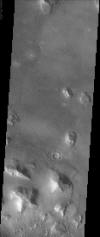
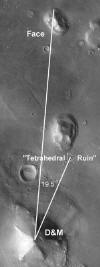

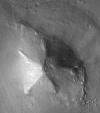


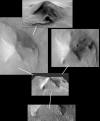
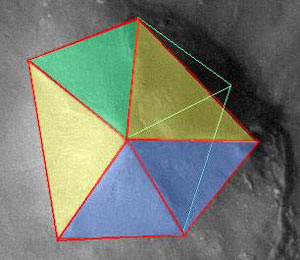 tumbles down the slopes of the
Pyramid and preferentially piles up at the corners of the
object. Forgetting for a moment that none of these geologic experts
seem to have noticed that the mass-wasting has put piles of debris
precisely at the five corners of a 1.5 miles high, bilaterally
symmetric, pentagonal Pyramid, our model is that these
are actually reinforcing "buttresses" that have a specific
architectural and mathematical function. Close examination of the
new image -- remember, twice as good as the Viking data
-- shows that these buttresses are indeed just that. They have a
very "boxy," geometric look -- and the Southwest buttress even seems
to have two rectangular openings (doors!?) in the base. The simple
truth is that no "mass-wasting" process produces rectangular box
shapes -- certainly not ones with several-hundred-foot-wide doors in
them!
tumbles down the slopes of the
Pyramid and preferentially piles up at the corners of the
object. Forgetting for a moment that none of these geologic experts
seem to have noticed that the mass-wasting has put piles of debris
precisely at the five corners of a 1.5 miles high, bilaterally
symmetric, pentagonal Pyramid, our model is that these
are actually reinforcing "buttresses" that have a specific
architectural and mathematical function. Close examination of the
new image -- remember, twice as good as the Viking data
-- shows that these buttresses are indeed just that. They have a
very "boxy," geometric look -- and the Southwest buttress even seems
to have two rectangular openings (doors!?) in the base. The simple
truth is that no "mass-wasting" process produces rectangular box
shapes -- certainly not ones with several-hundred-foot-wide doors in
them!


